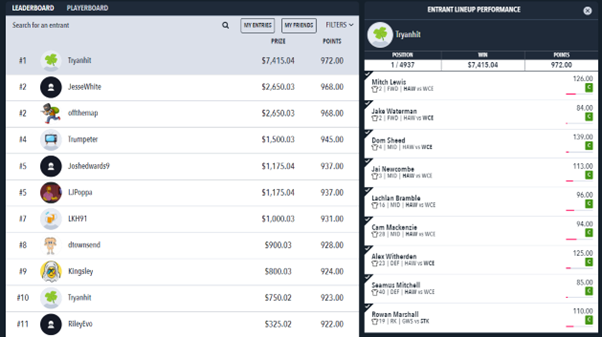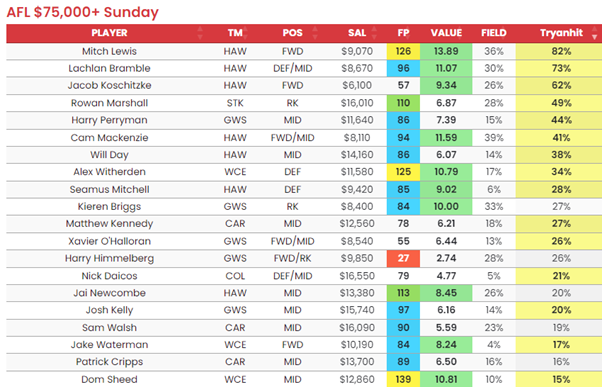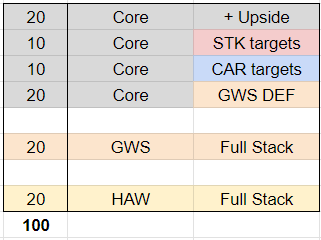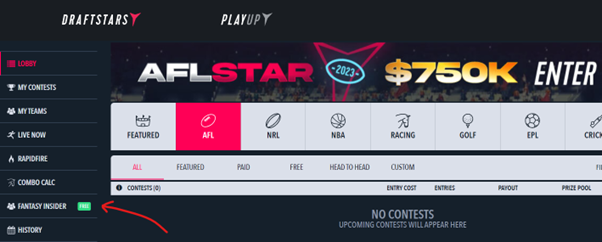In the next edition of our Education Series, ‘Tbetta’ deep dives in the mass multiple entry (MME) strategy.
In the last How To Win article, I covered some basic strategies for taking out big tournaments with limited entries. You’ll probably not be so shocked to learn that what’s good for one line-up is also good for many, so now that we’ve ticked off those gateway concepts, let’s investigate multi-entry strategy!
QUALITY CONTROL
In my opinion, the hardest thing about MME (mass multi-entry) is taking those concepts that we look at for limited entries – being unique, writing game scripts, limiting the luck factor, maximising correlation – and being able to bake them all into every single line-up effectively. To do so either requires a ton of time and effort to handcraft and authenticate every line-up you create, or by taking some time upfront to learn how to use an optimiser to get what’s in your head, onto paper, accurately.
It probably goes without saying, but the latter is strongly preferable. DFS is supposed to be fun, and grinding away for hours with spreadsheets and cold coffees for multiple slates a weekend just isn’t that enjoyable – trust me, I’ve done it. And that’s even if you’ve got the free time available – families and social commitments are the natural enemy of fantasy footy.
So let’s focus on crunching to achieve our DFS dreams, and some simple tips to help you get started.
R&D
The first thing to do is get yourself an optimiser, and familiarise yourself with the technology. While you can create your own, it requires some knowledge of coding and it’s quite a big undertaking. I recommend using something like Fantasy Insider (which is available on the Draftstars platform for free) or one of the other crunchers in the community – it really doesn’t matter. What’s important is that you take the time to get comfortable with the process, and invest some time into ironing out the kinks well before exposing your bankroll to more experienced max-enterers and the more refined single bullets.
For this reason, I strongly suggest new MME players start by focusing on the $2,000 Micro contests, which are specifically designed (and shark-proofed!) to help casual players figure out multi-entry DFS. At $0.50 per entry and with the ability to enter 100 different line-ups, this is the perfect way to dip your toes in the max-entry waters whilst also protecting your bankroll.
I’ll cover the minutiae of crunching on Fantasy Insider in a future post because there’s a fair bit to it technically, so we’ll focus just on the strategy behind it in this article.
DEFINING VALUE
Before you start crunching, you need a way of evaluating players. The easiest way to do this is to ponder their likely X value – basically their projected/eventual scores divided by their salary (in $1000). For example, George Wardlaw debuted over the weekend at $6,000, where he scored 82. His X-value was therefore 82/6, which equals 13.67 – making him an extremely good pick for his price.
But wait. What’s “good” value and what isn’t?
As a general rule, to win a GPP or a big tournament, you’re probably going to have to score at least 900 points. So, 900 points with a $100,000 salary means that you require roughly 9X value from all of your players, on average.
Of course, it’s much harder for the guns of the competition to score at 9X given their inflated salaries (Tim English at $16,000 has to score 144, for example) so I find that it’s more helpful to consider prospective players on more of a sliding scale:
- $6k – $9k: 11X
- $9k – $12k: 10X
- $12k-$15k: 9X
- $15k+: 8X
This is quite simple to use, yet so powerful. Do you think that Jake Stringer at $10,500 can score 105, which would be 10X value? If so, he’s a great pick. What about Trent McKenzie at $7,000? Can he upswing for 11X with a score of 70, perhaps on the back of a soft match-up for defenders? And so on you go.
If you’re ever stuck on whether to pick a certain player, simply go back to the mathematical basics and consult the value index.
DEBUNKING EXPOSURES
You might have heard the term ‘exposures’ thrown around in DFS, which is essentially the percentage of your line-ups that feature a certain player. It’s a bit lazy though – much in the same way that we incorrectly use the term “CBAs” interchangeably with more midfield time in the fantasy community, exposures don’t tell the full story. Much more important than your ownership is where you own that player.
Let’s say you have 20% Jack Riewoldt at $9,000. The Tigers are playing the Roos and you think he could be in for a big day – and you’re right. He scores 100, which is the juicy 11x we’re always looking for.
But if you haven’t been paying attention during the crunching process, you might have spread those 20 Jack Riewoldt line-ups amongst your 100 overall line-ups, rather than going heavier in those planned Richmond Stacks. Or even worse, you might have him littered throughout a lot of your North Melbourne underdog stacks, which is a correlation nightmare for a key forward.
CHOOSE YOUR CORE
This is where it’s important to identify which players you consider to be “core” picks, and which are more game script-based upswings.
Typically, your core picks are players that’ll reach their value point regardless of the game script. They may be extremely underpriced due to injury, they might be stepping into a bigger role with a key teammate missing, or they might just have a dream match-up. Either way, you want to be so convinced of their projected value that you’d be happy to play them in any stack, essentially fit for DFS selection whatever the results of the actual game(s).
Using the examples previously, Jack Riewoldt might be more of a “stacking” play than a core pick. If North Melbourne controls the play, Jack is unlikely to kick a bag, and therefore you don’t want Riewoldt popping up in North Melbourne-themed line-ups. Reigning #4 draft pick George Wardlaw at basement price however, with a midfield role seemingly locked – now this is much more “core” pick territory.
The “correct” number of core players is so situational that it’s not even specifying a rule of thumb. Not only does it depend on your overall strategy, but things like the number of games on a slate, the number of “obvious” value picks, positional scarcity – it’s all very intuitive and iterative and can change wildly from slate to slate.
Let’s take a break from throwing around concepts and look at an actual example. DFS veteran Tryanhit took out top spot and $7,415.04 in Round 10’s AFL $75,000 Sunday with this awesome line-up below:

From the outside looking in, this looks like an incredible bink. Seamus Mitchell at 6% field ownership%? Jake Waterman at 4%? Bullshit, right?
In reality, it was anything but. Below is Tryanhit’s overall exposures on the Sunday slate. Not only did this line-up contain 6 of his 9 most selected players, the “upswing” players that rounded out the line-up in Sheed, Waterman and Newcombe were all within his top 20.

Image courtesy of DFS Australia’s Historical Ownership tool.
This is the classic recipe for success, when your core just hits. As you can see above, 7 of his top 10 most selected players exceeded that magical 9X value mark, while his huge 82% exposure to the best-value player on the slate in Mitch Lewis and his massive 13.89X ensured profit. Ultimately, Tryanhit secured not only the bag, but 13 of the top 100 positions on the leaderboard.
PRE-CRUNCH PLAN
I can confidently say after years of upswings and downswings, the most vital 30 minutes of preparation for any slate is the half an hour you spend figuring out where you want to spend your money and how you want to spend it. Under no circumstances should you skip this step – or you’ll get to the end of the process and wonder how you managed to create 100 line-ups you hate.
Here are the general steps I follow:
- Identify your core.
- Identify the high-upside picks.
- Decide on the stacks and targets you like the most.
- Assign a rough number of line-ups to each scenario.
Parts 1 and 2 can be done within the cruncher, by adding the players to a shortlist and by curating their projections and exposures. Parts 3 and 4 can be written down somewhere – I usually use Excel. This will keep you on track and focused as you wrestle the optimiser Gods.
Here is a very basic example of my general pre-crunch plan for the Sunday slate:

As you can see, the key element here is that you’re not actually crunching 100 teams at once (for instance). That would be like taking your week’s groceries and throwing them into a big soup rather than cooking them in separate recipes – probably disgusting and a waste of money. Instead, you’re crunching a bunch of different batches of line-ups, each with their own theme or game script, to be part of an overall greater strategy.
GREATER STRATEGY
This is the fun part! From the beautiful balance of Broady4_’s line-ups to the perfect projections of Rwhelan09, the optimism of arparp to the extremities of split_tens – there are so many ways to skin a cat in AFL DFS. We’ll cover the main strategies and the pros and cons for each in a future article, but for now, start playing around with those crunchers!
Tbetta.










